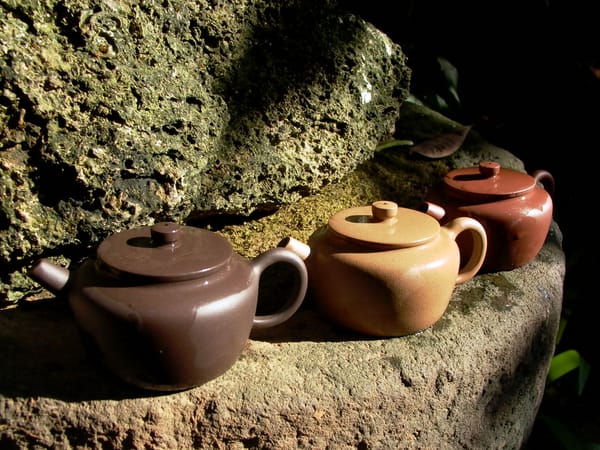Instantly Spot the Era: Unraveling the Mystery Behind a Teapot’s Age
Have you ever held a Yixing teapot in your hand, gently running your fingers over its clay body, wondering which era it came from? Is it a precious relic from the Kangxi reign of the Qing dynasty, or a beautifully crafted modern replica? For countless teapot lovers, this question lingers. Fortunately, there's now an elegant and simple method that sheds light on the answer—the Isosceles Triangle Rule.
As modern technology continues to enhance the precision of Yixing teapot reproductions—especially popular types like those mimicking the Kangxi-era Mengchen pots—it becomes increasingly difficult to tell genuine antiques from newer imitations. One of the most frequently asked questions by new collectors is:
"How can I tell whether a teapot is a true antique or a contemporary replica?"
Beyond examining maker’s marks or inscriptions, there is a subtle yet powerful way to assess a teapot’s authenticity and age: the Isosceles Triangle Rule.
Lifting the Veil on a Teapot’s Origin
Determining the age of a Yixing teapot has long been a deep and complex subject for collectors. Generalized dating methods often lead to hesitation and uncertainty—was it made during the Kangxi era or the Qianlong reign? Rather than getting trapped in this gray area of dating antique teapots, it's more fruitful to focus on the spirit and proportions of the pot. That’s where a teapot’s soul truly resides.
Think of it like recognizing an old friend. Even if they're wearing new clothes, their expressions and gestures give them away. The same goes for Yixing teapots. While two may appear similar in shape and size, their spirit (shen yun)—the intangible grace they exude—is often what separates an antique from a replica. Once you learn the fundamentals of identifying genuine Yixing teapots, you’ll become much more confident in discerning their true origin.
What Is the Isosceles Triangle Rule?
This “crime-solving” tool might sound mathematical, but it's surprisingly intuitive. The idea is to imagine an inverted isosceles triangle over the teapot. This triangle can reveal whether the teapot’s proportions are harmonious—something the masters of old prioritized in their craft.
How to Apply the Isosceles Triangle Rule
Just follow these three steps:
- Observe the base of the teapot: Treat the center of the base as the triangle’s bottom point.
- Locate the spout and handle: Imagine these as the triangle’s two upper corners.
- Visualize an upside-down isosceles triangle connecting the spout and handle.
If the spout and handle align symmetrically and the triangle appears naturally balanced, congratulations—you may be looking at a well-proportioned piece from an earlier, more refined era. This overall harmony is precisely what ancient teapot artisans strived for, and it's one of the key clues in any teapot authenticity check.
Case Study: Kangxi-era Mengchen Pot vs. Modern Replica
Let’s look at a concrete example. Suppose you have a Kangxi-era Mengchen teapot in one hand and a modern reproduction of the same style in the other. Both have high-walled lids and seem nearly identical at first glance. So, how do you tell them apart—especially when they’re two centuries apart?
Unique Characteristics of Kangxi Mengchen Pots
The answer lies in their spirit and proportions. A genuine Kangxi Mengchen teapot features a spout that’s rich and elegant, like a slender jade finger—lively and confident. In contrast, the replica’s spout may match in size, but close inspection reveals awkward or unnatural lines.
When you apply the Isosceles Triangle Rule to both pots, you’ll see the authentic teapot’s spout and handle fall into a natural rhythm within the triangle. The replica, however, often appears stiff or poorly balanced. This method of evaluating a teapot’s spirit and form is incredibly helpful for anyone—even without formal training—to get a first impression of authenticity.
Identifying Teapot Characteristics Across Dynasties
Each historical period has its own signature teapot styles. Understanding these can further support your judgment when using the triangle method.
Ming Dynasty Yixing Teapots (1368–1644)
- Predominantly square, round, or melon-shaped (jin nang)
- Minimalist lines with larger bodies
- Heavier, more rustic feel
- Simple and practical for daily life
Early Qing Dynasty Yixing Teapots (1644–1735)
- Finely detailed pots for imperial use
- Designs rooted in nature and geometry
- Civilian pots are smaller, with shorter spouts and tiny handles
- Compact and precise proportions
Late Qing to Early Republic Era (1850–1949)
- Increased variety in styles and decorative elements
- Often imitative of earlier masterworks
- Less innovation in form, more emphasis on decoration
- Utility gradually gave way to aesthetics
When viewed through the Isosceles Triangle Rule, these period traits become more distinct. Much like tasting fine tea reveals layers of flavor, this antique teapot identification method helps us “taste” a pot’s historical depth.
Beyond Maker’s Marks: Evaluating Form and Spirit
Many collectors rely heavily on base markings or inscriptions to assess age. But these can be forged. What cannot be easily duplicated is a pot’s spirit and visual rhythm. The triangle rule shifts your attention back to the teapot’s intrinsic proportions—arguably a more reliable metric.
A Lesson from the Museum
Take the “Dabin-Tiangxiangge Teapot with Raised Handle” from the Nanjing Museum, for instance. Though authenticated as a high-level imitation from the late Ming period, it is widely praised for its exquisite proportions and elegant balance:
"The base is wide and flat, grounding the pot with stability. The body subtly rounds below the shoulders, lowering the pot’s center of gravity and giving it a sense of calm. The tall, arched handle rises like a rainbow, forming a vast, open space above the body—serene and unbounded."
Such deep appreciation of a teapot’s form and spirit is what we should strive to develop. Regardless of whether the pot was truly made by the legendary Dabin himself, the craftsmanship alone offers immense artistic value.
Practical Tips for Using the Isosceles Triangle Rule
For newcomers to the world of teapots, this rule serves as a simple, hands-on entry point. No technical knowledge required—just a keen eye and a willingness to observe.
How Beginners Can Start Using the Triangle Rule
- Start with reference examples: Use museum photos or professional catalogues.
- Try measuring with tracing paper: Overlay an inverted triangle on your own teapot.
- Compare different pieces: Choose teapots from various periods or skill levels.
- Focus on spout-handle balance: This is the heart of the method.
- Train your eye: Observe, compare, and build visual intuition.
Over time, you’ll find the triangle method is just the beginning. The real art of teapot identification comes with experience and the development of your own “pot sense”—the instinctive ability to recognize a pot’s era, form, and craftsmanship at a glance.
The Journey from Form to Spirit
The Art of Teapot Appreciation, Beyond Appearance
The Chinese philosopher Zong Baihua once wrote:
“To capture likeness through unlikeness is to abandon form and seek the shadow. Though intangible, the shadow expresses the spirit—the subtle truths of life that are hard to mimic. That is where life lies. That is where spirit and rhythm reside.”
The Isosceles Triangle Rule is a bridge that takes us from form to spirit, helping us better appreciate the soul behind these ancient works of art. Whether you're a seasoned collector or a curious newcomer, this method will deepen your understanding of Yixing teapots.
Real Insight Comes from Practice
Next time you pick up a teapot, try applying the Isosceles Triangle Rule. You’ll soon discover that the world of teapots is far richer than you imagined. And the joy of identification goes far beyond simply knowing a pot’s age—it lies in truly seeing its character.
When you combine this method with a deeper understanding of a pot’s aesthetic spirit, you’ll realize that teapot appreciation isn’t just for experts—it’s something every tea lover can enjoy.
In the quiet moments shared over tea, let us learn to savor not just the brew, but the soul of the vessel that holds it. After all, a great teapot is not just an antique—it’s a trusted companion on your tea journey.



